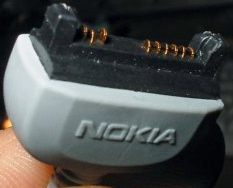Nokia Pop-Port

The Pop-Port interface (originally code-named "Tomahawk"[citation needed]) was a plug-in port, available with many Nokia mobile phones. The port consists of one metal pin on either end, and a plastic tab containing thirteen contacts.
Functions
The port contains signals for hands-free microphone, stereo speakers, FBus Rx/Tx or USB signals for the phones supporting them, power output for feeding the accessories that do not have their own batteries, and the Accessory Control Interface (ACI), a bidirectional serial control bus for connection and authentication of phone accessories, with a specific ASIC inside accessories and a proprietary protocol. It is also used to upgrade USB-enabled phones' software using a specific USB data cable and the Nokia Software Updater.
Criticism
A common problem with Pop-port was that contacts often lost connection, thus resulting in drop-outs in audio (when a hands-free is used) or an unstable data connection (when a USB cable is used). This was a common problem when listening to music from the phone while the phone was in a pocket. The more stable 2.5 mm and 3.5 mm audio sockets aren't prone to such problems.
The contacts were exposed to dust and dirt, more than the contacts of a TRRS socket are. This, combined with the small size of the contacts, prevented connections in some cases. Also, the plug's 'hook' tended to lose its hooking capability, making it even easier to accidentally lose connection. The data cables had to be original in most cases.
Post-2007 phones
Nokia phones made since 2007 use mini-USB or micro-USB sockets for data services and a 4-part 2.5mm or 3.5mm "standard" TRRS socket for audio.[citation needed] Some models also use microUSB for charging.
Available Pop-Port plug-ins
- Camera
- FM radio
- Headphones
- LCD display remote controller
- USB cable
- 3.5mm stereo plug adapter
- Flash
- 8P8C (RJ-45) cable (CA-41)
- CarKit
Similar connectors
A similar connector is the Sony Ericsson FastPort.
External links
- Nokia Pop-Port connector pinout nokia-tuning.net
- Nokia Pop-Port pinout pinouts.ru
